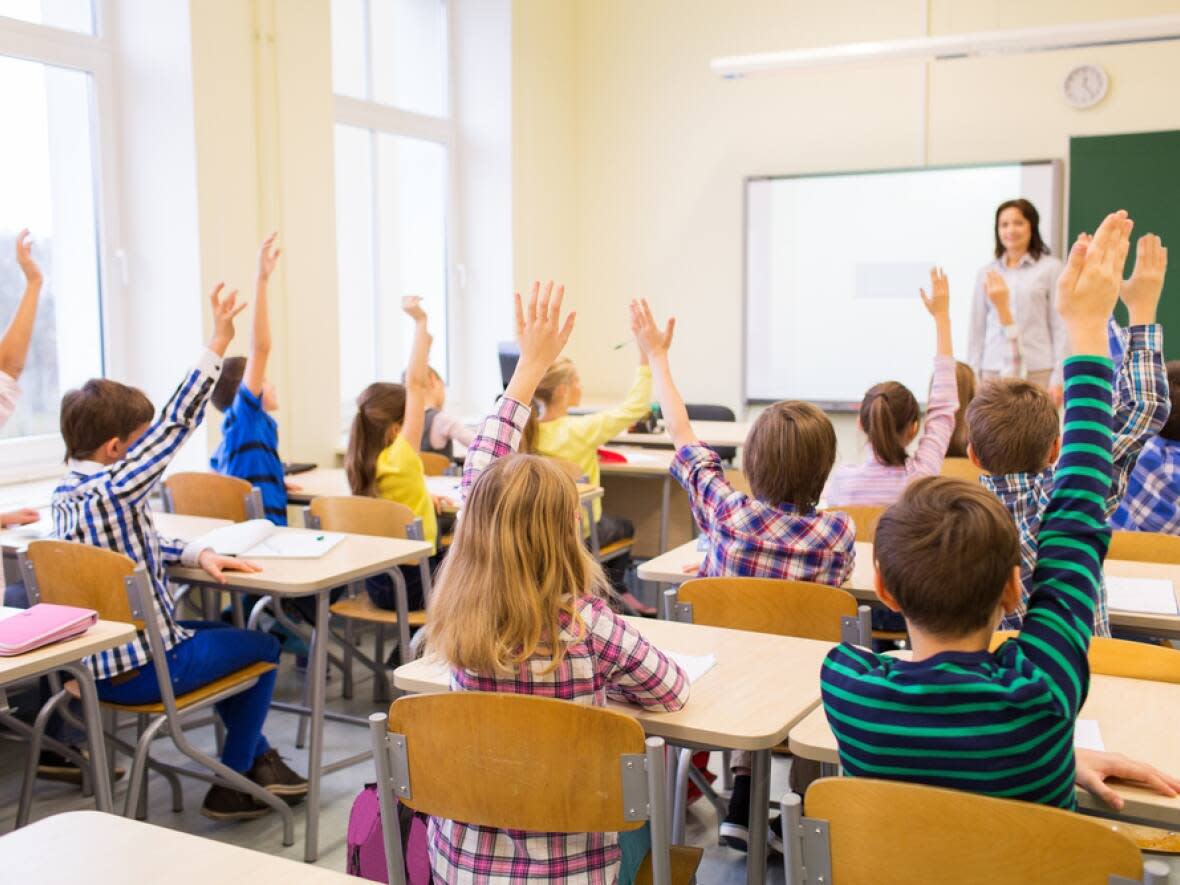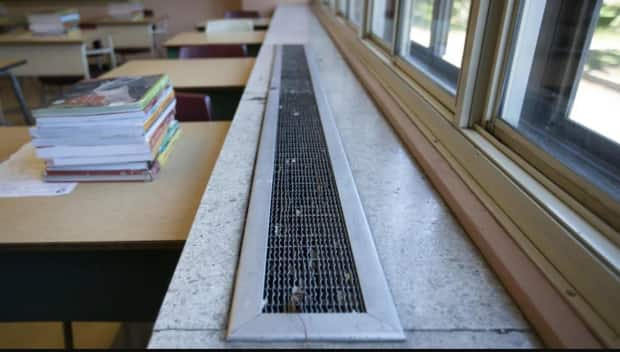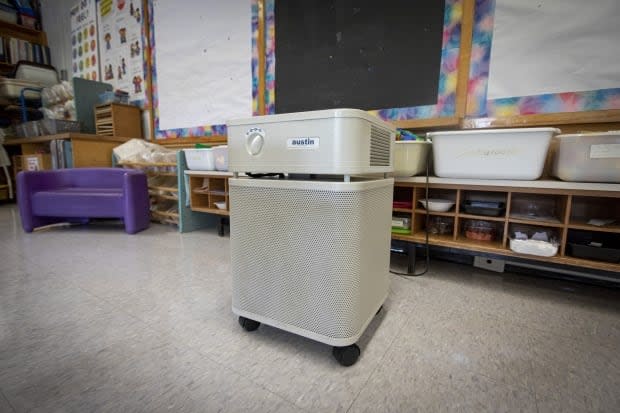Air quality tests underway at 37 N.B. schools that had high CO2 results last year

Air quality testing is underway at 37 New Brunswick schools that tested high for carbon dioxide last year, the Department of Education has confirmed.
Elevated carbon dioxide levels are considered "less than optimal for learning," the department has previously said, and can contribute to the transmission of COVID-19 and other respiratory illnesses, according to experts.
Carbon dioxide, or CO2, is a odourless, colourless, non-flammable gas commonly created indoors when people exhale. It is used as a proxy to measure the overall air quality and rates of air exchanges in a space.
The department conducted tests last winter at the 51 schools that showed elevated levels the previous year when all 64 schools without proper ventilation systems were tested.
The 2021-22 results still haven't been released, but 37 of the schools "displayed peak carbon dioxide levels above 1,500 parts per million," said department spokesperson Morgan Bell.
I think it's safe to say that no room in any school anywhere should ever be at 1,500. - Colin Furness, infection control epidemiologist
The highest reading was 3,914 ppm. This was "only for a brief period of time and posed no health risks," she said.
All the results were "within the safe range," according to Bell, and "do not indicate any risk to the health or safety of an individual.
"However, higher CO2 levels for a sustained period of time can increase fatigue and decrease attention spans," she said.
Bell declined to disclose any other details, including the identity of the schools, saying the results will be available online at some point.
Important piece of child health ignored for too long
Colin Furness, an infection control epidemiologist and assistant professor at the University of Toronto, describes the results as "concerning," and the fact they haven't been publicly released yet as "appalling."
"I think it's safe to say that no room in any school anywhere should ever be at 1,500," he said.
"The more exhaled air there is, the higher the risk that people will breathe in exhaled air and viruses that go along with it and … mould and bacteria and other things too. So air quality is a really big, broad important thing."
Generally, the typical indoor guideline for CO2 is 1,000 ppm, according to National Collaborating Centre for Environmental Health. This has been scaled down, however, during the pandemic. The U.S. Centers for Disease Control and Prevention, for example, recommends maintaining CO2 levels below 800 ppm.

In New Brunswick, Bell said 1,500 ppm "was identified as the peak desirable CO2 readings for schools," in consultation with WorkSafeNB and the Department of Transportation and Infrastructure.
"CO2 exposure does not pose a health risk unless the exposure is at a level of 5,000 ppm over an eight-hour period weighted average or 30,000 ppm over a [15]-minute period weighted average," she said in an emailed statement.
Furness contends the government is taking "increased risks" once CO2 levels exceed 1,000 ppm, particularly during a "deadly pandemic," and when "schools are such vectors for disease."
"Kids could be a lot healthier and they could spend more of their time in school instead of sick at home," he said. "Parents could spend more time at work instead of taking care of sick kids. So it's not just COVID, it's actually a really important piece of child health and it's been ignored for far too long."
Fall surge of absences, illnesses
New Brunswick has seen some record-high student and teacher absences in recent months that forced the cancellation of some classes. Although the reasons for the absences are unclear, they occurred during a surge in respiratory syncytial virus, or RSV, the flu, and ongoing COVID-19 pandemic that had health officials worried about the added strain on hospitals.
Only about 2.3 per cent of school-aged New Brunswickers have received a fourth dose of a COVID-19 vaccine, according to figures provided by the Department of Health.
That includes 2,073 aged 15 to 19, 622 aged 10 to 14, and 38 aged five to nine.
About 13.7 per cent have received three doses, 62.1 per cent have received two doses and 72.5 per cent, one dose.
"With the COVID-19 pandemic still evolving, dose counting is not as meaningful as it once was in understanding the booster uptake," said department spokesperson Sean Hatchard.
He noted people who have received a booster within the past five months are considered up to date, but did not provide that statistic for school-aged New Brunswickers.
Formulating data can take some time
Furness called for the release of the school air quality results and testing methodology, noting governments are "supposed to be accountable and transparent.
"When you do this sort of test, you have an obligation, moral obligation, I think, to report it, even if the news is bad."
Department of Education staff are "working on formulating the data in order for it to be posted publicly on the department website," Bell said.
CBC has checked back a number of times over the past several months and received the same response.
"This can take some time depending on the amount of information," Bell said.
She did not respond to a request to elaborate on why it has taken a year. Nor did she say how much longer it's expected to take.
In Quebec, CO2 detectors have been installed in all classroom, and weekly air-quality reports are posted online.
School districts were informed
"School districts received all test results and have taken measures to reduce CO2 levels on a case-by-case basis to best respond to the specific configuration of spaces within the schools," Bell said.
"Often, mitigation is as simple as ensuring there are more opportunities for air exchange." This can include installing exhaust fans, opening doors and windows, or having the students "move more freely through the school" throughout the day, she said.
Asked whether the results have been shared with parents, teachers and staff, Bell redirected inquiries to the school districts.
Francophone District North West was the only district to respond to a request for comment on the 2021-22 results. None of its schools were included in the testing because they all have mechanical ventilation systems, said spokesperson Julie Poulin.
Asked whether the teacher's union was advised of the results or how it feels about them, Connie Keating, co-president of the New Brunswick Teachers' Federation, did not answer directly.
"The issue of school ventilation and air quality has been a longstanding issue in many schools," she said in an emailed statement. "It is unfortunate that it took a pandemic to bring much-needed attention to this issue and we are hopeful that this will prompt decision-makers to make more investments to improve the situation impacting learning and working conditions."
Asked what value there is in posting air quality results a year after the fact, the department spokesperson said, "It's good to have data on our websites representing the past and present years for comparison and an individual's personal evaluation."
'Urgent,' 'fixable problem'
Furness argues the results should be treated as "urgent."
"It's child health, is what it is."
He encourages parents to "be outraged" and "make a lot of noise." They should contact their school principals, school trustees, superintendents, city councillors and their members of Parliament, he said.
"Governments will act when people are outraged."
This is a "fixable problem," stressed Furness. "The first thing you need to do is identify how bad the problem is and where the problem is and then spend a little bit of money" to ensure adequate ventilation systems.

Eleven schools are expected to receive a new ventilation system this year, said Bell, including:
Birchmount School (Anglophone East)
Marshview Middle School (Anglophone East)
Keswick Ridge School (Anglophone West)
Dorchester Consolidated School (Anglophone East)
Frank L. Bowser School (Anglophone East)
Harold Peterson Middle School (Anglophone West)
Nackawic Senior High School (Anglophone West)
Sir James Dunn Academy (Anglophone South)
Blacks Harbour School (Anglophone South)
St. George Elementary (Anglophone South)
Donald Fraser Memorial School (Anglophone West)
"This list could be subject to change should unforeseen issues be discovered during the design process," noted Bell.
Birchmount School was slated to be upgraded last year but got postponed "because of certain mechanical issues," she said. The other 10 were completed, as planned.
Bell could not say why another school wasn't upgraded last year in Birchmount's place, or provide the estimated cost of this year's planned upgrades.
Results from the current testing will determine which schools will be targeted for upgrades in 2024, she said.
"We expect this year's findings to be similar to last year's."
Testing reduced to once a year
The schools will only be tested during the winter, Bell said.
Just three months ago, she told CBC, "Testing is done every summer and winter during the school [year], this includes peak periods when schools are full and when they are empty."
Asked at the time about the value of testing classrooms when they're unoccupied, she replied, "Continuous testing over extended periods is required when both students are in class and out of class in order to gain a full portrait of the air quality in that location.
"This includes getting baseline readings when the space is unoccupied."
Earlier this week, Bell told CBC, "Schools are not tested in the summer as the occupancy of the buildings is low."
She could not immediately explain the switch to testing only once a year.
The department "hopes" to have the results posted in the summer, she said.
Change in 2020-21 results
The online 2020-21 results are not accurate, Bell confirmed.
They indicate 47 of 60 schools without integrated mechanical ventilation systems had C02 levels peak above 1,500 ppm. But Bell said it's actually 51 of 64 schools with no mechanical or centralized air-handling units that had elevated levels. The highest reading was 4,406 ppm.
After the testing, one or more districts informed the department of four additional schools without adequate ventilation and those schools were also tested, said Bell.
She could not say when that occurred or why the website hasn't been updated to reflect the higher numbers.
The department originally told CBC in September 2021 only 24 schools had peak CO2 levels above 1,500 ppm.

Schools without an integrated mechanical ventilation system will continue to use portable HEPA filtration systems, Bell said.
The department installed 2,000 portable HEPA systems in classrooms of the schools that lack a ventilation system in January 2022.
Bell did not respond to questions about whether schools will accept donations of HEPA filtration systems, filters or homemade air purifier systems known as Corsi-Rosenthal boxes.
Air quality testing is not currently required at schools with a ventilation system, said Bell.
"This is something the department will look at in more detail in the future as part of a potential second phase of the ventilation program," she said.


